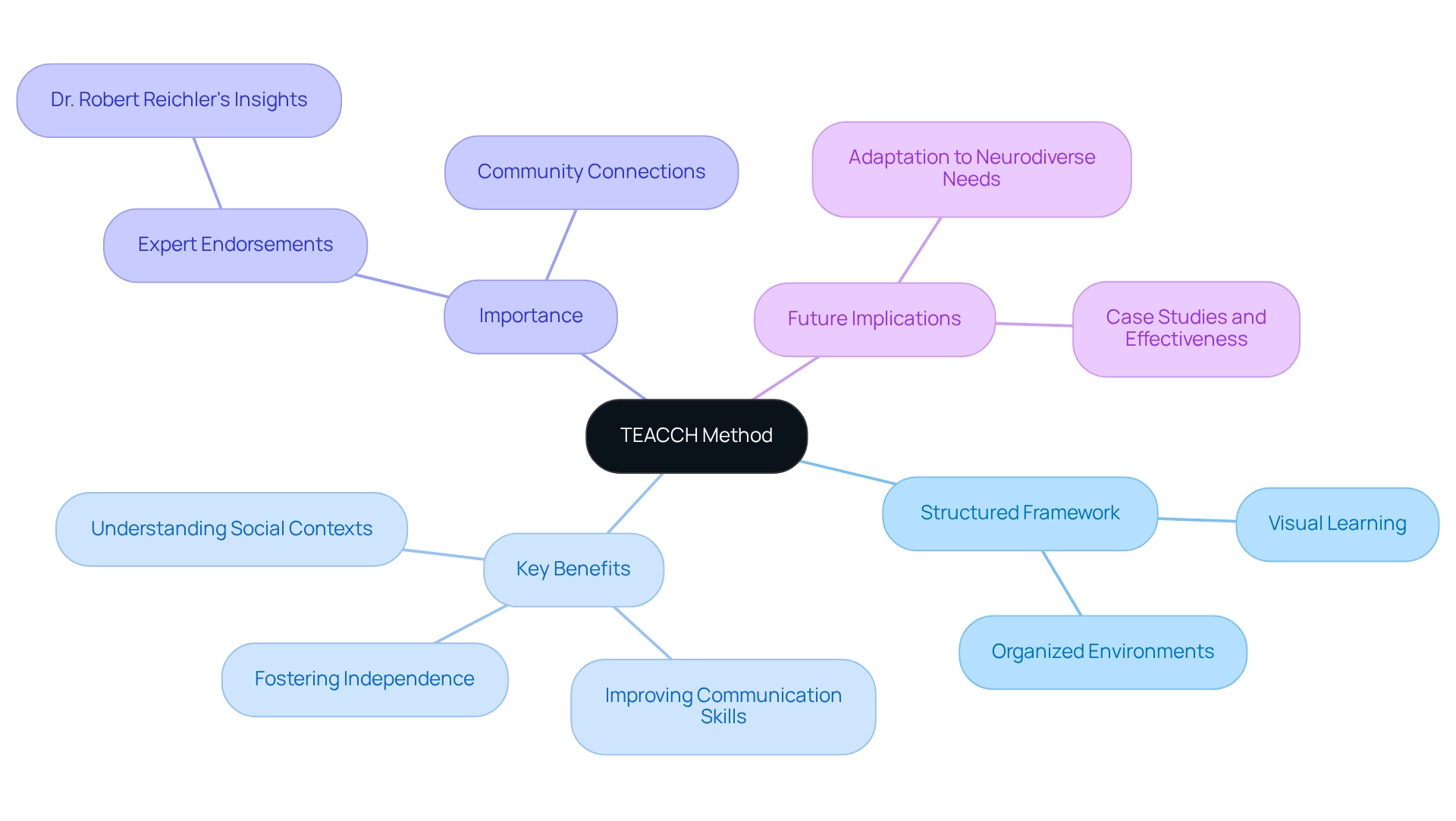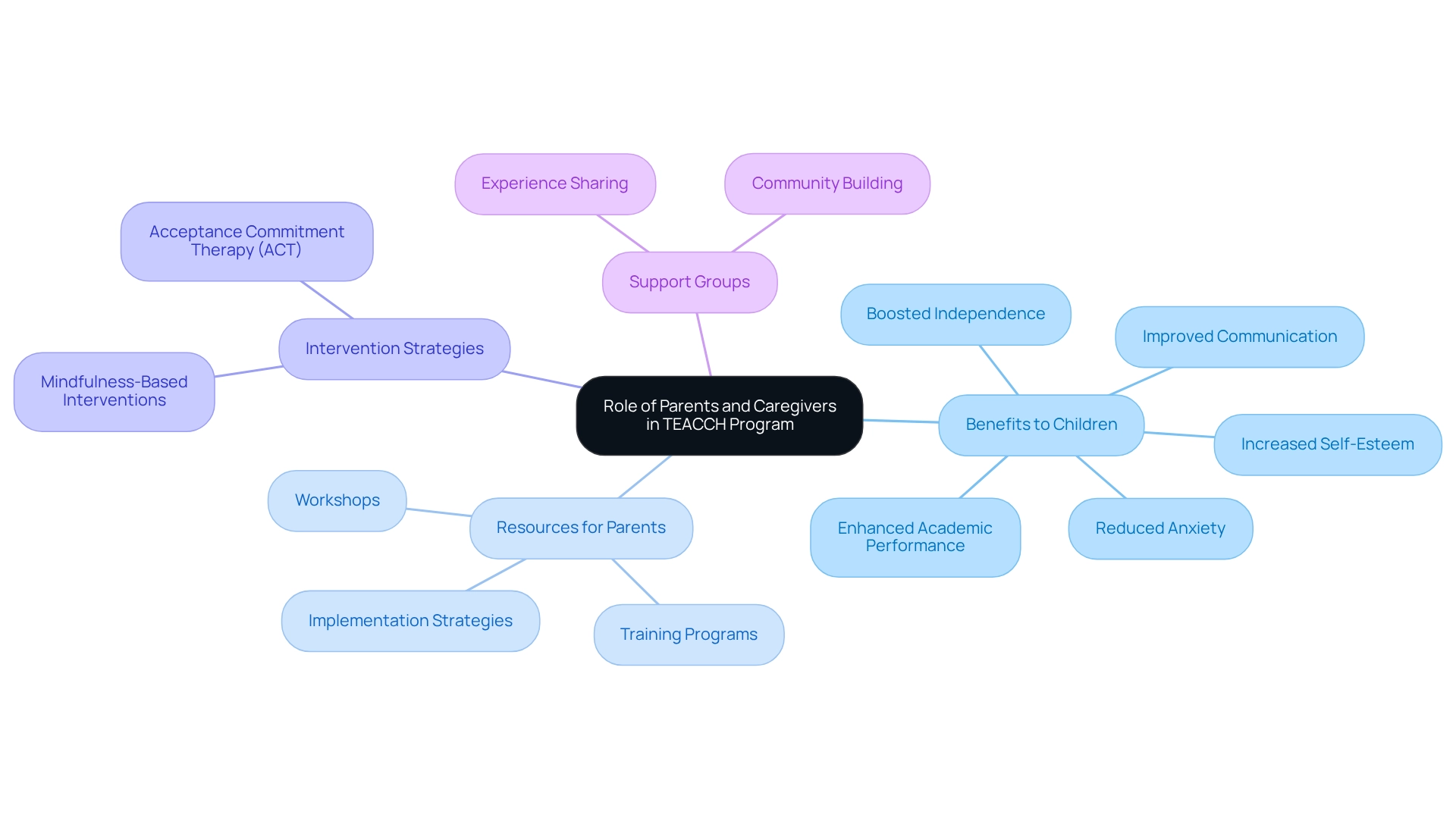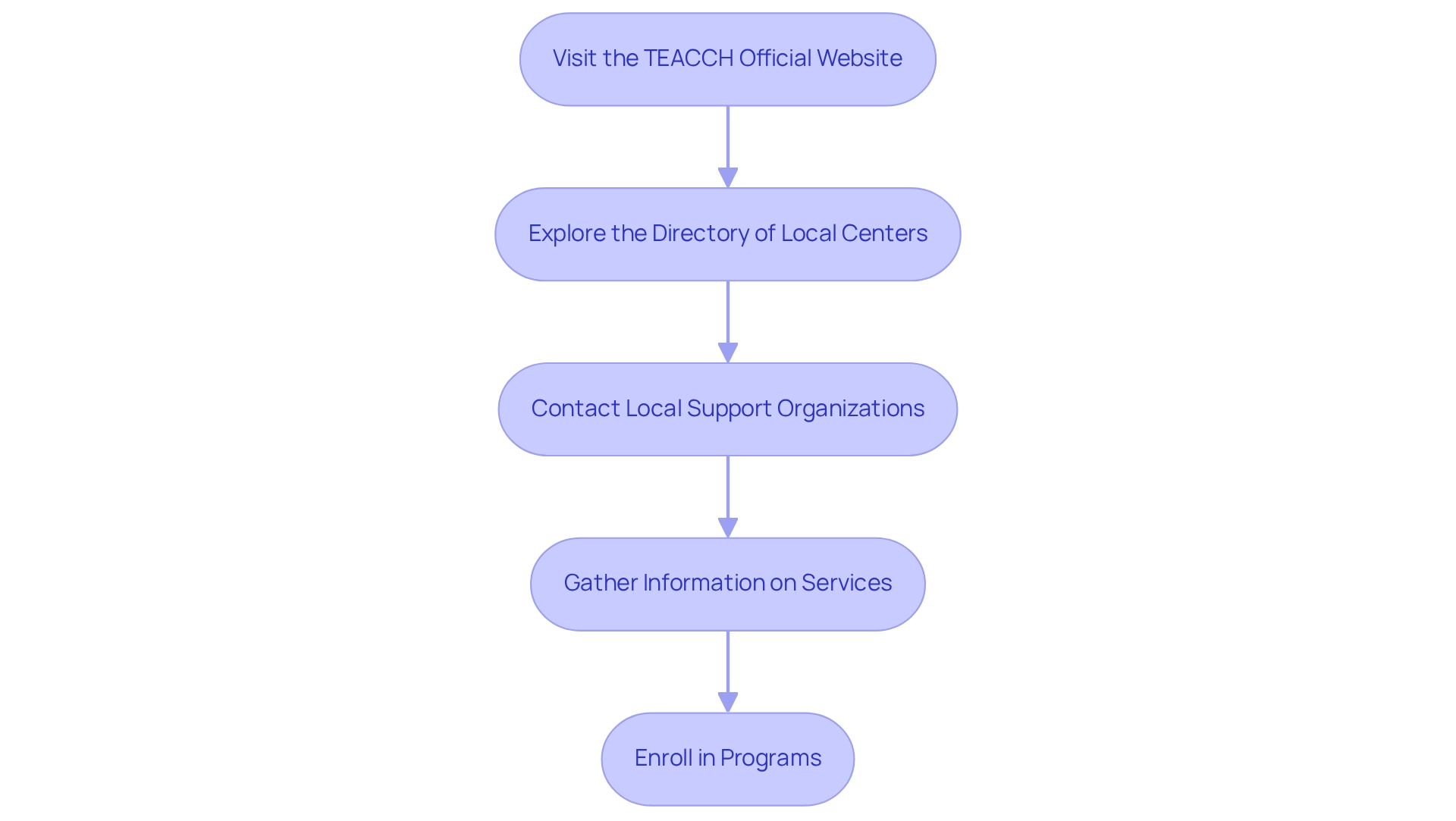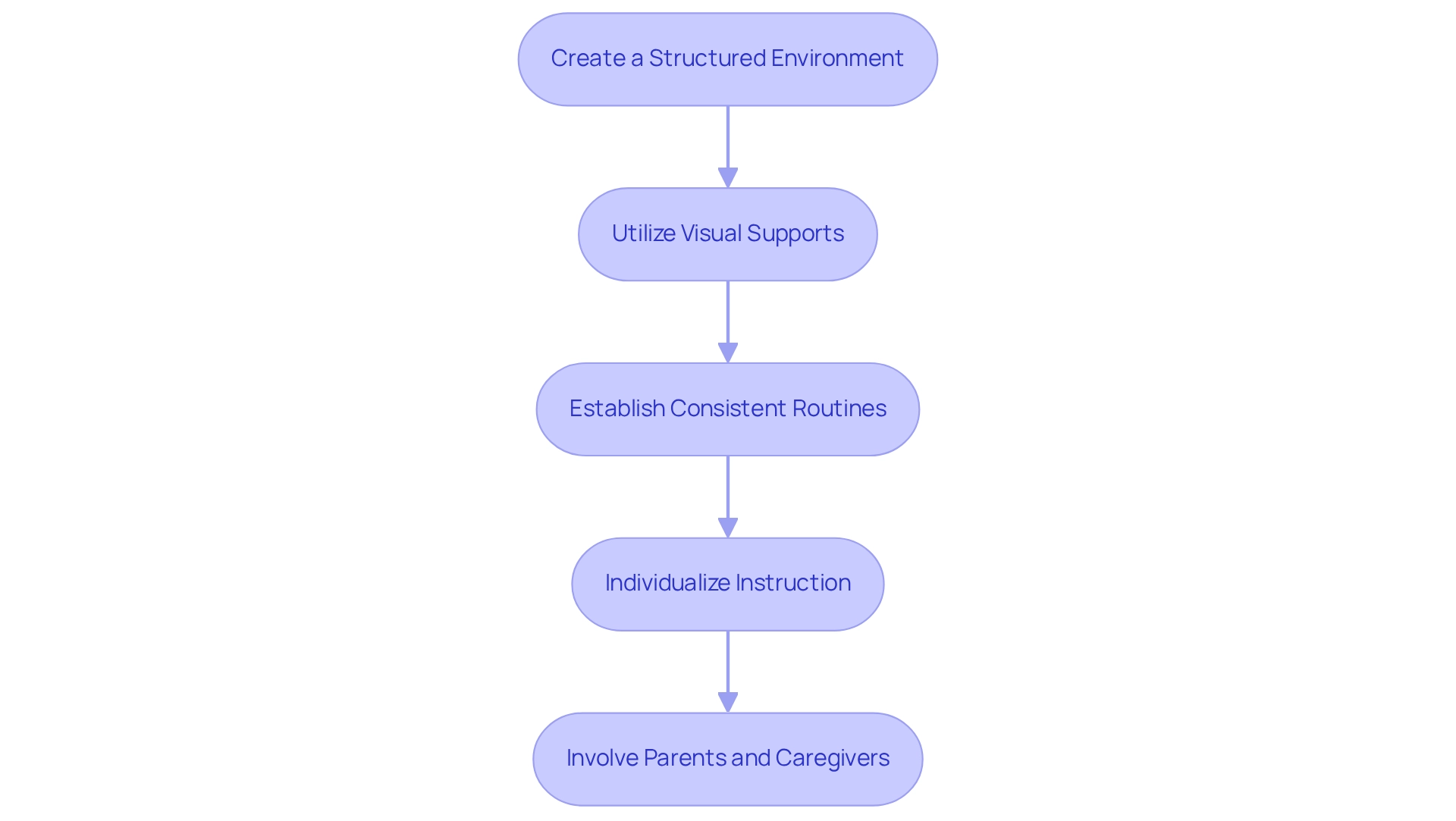Overview
The TEACCH method offers a structured approach that truly supports individuals with autism spectrum disorder (ASD). By emphasizing visual learning and organized environments, it significantly enhances their learning and social interaction abilities. This method has proven effective, fostering independence and improving communication skills, which are crucial for navigating social contexts. Remarkably, research indicates a 30% increase in task completion rates among children with ASD who utilize these strategies.
For parents, understanding how the TEACCH method can impact their child's life is essential. Imagine your child feeling more confident and capable, successfully completing tasks that once seemed daunting. This structured support not only aids in learning but also nurtures social interactions, helping children develop meaningful connections with others.
As you explore the TEACCH method further, consider how it can be a valuable resource in your journey. It’s about creating an environment where your child can thrive, fostering skills that lead to greater independence and understanding. We encourage you to share your experiences and thoughts in the comments or through our newsletter. Together, we can build a supportive community that uplifts each other and our children.
Introduction
In the world of autism support, the TEACCH method shines brightly as a guiding light for structured learning and empowerment. Developed in North Carolina during the early 1970s, this innovative approach is thoughtfully designed to address the unique needs of individuals with autism spectrum disorder (ASD). By focusing on visual learning and organized environments, the TEACCH method leverages the strengths associated with visual processing. This not only enhances communication and social skills but also nurtures independence, ultimately enriching the quality of life for those it serves.
As the demand for effective autism interventions continues to rise, it becomes increasingly vital for parents, educators, and professionals to understand the principles and applications of the TEACCH method. By doing so, they can better support individuals with ASD in their journey towards growth and fulfillment.
What is the TEACCH Method and Its Importance in Autism Support?
The TEACCH methods offer a structured framework for the Treatment and Education of Autistic and Communication Handicapped Children, thoughtfully designed to support individuals with autism spectrum disorder (ASD). This approach emphasizes visual learning and organized environments, catering to the unique needs of autistic individuals. By harnessing the strengths associated with visual processing, children can gain a clearer understanding of their surroundings, significantly enhancing their learning and social interaction abilities.
Key benefits of the TEACCH methods include:
- Fostering independence
- Improving communication skills
- Deepening the understanding of social contexts
These advantages collectively enhance the quality of life for those on the spectrum. For instance, research indicates that organized visual aids can lead to a remarkable 30% increase in task completion rates among children with ASD, showcasing the approach's practical effectiveness.
Experts underscore the importance of the TEACCH approach in supporting individuals with developmental disorders. Dr. Robert Reichler, a co-creator of the technique, remarked, 'This renowned approach to developmental disorder intervention utilizes TEACCH methods and emphasizes structured visual learning strategies,' highlighting its foundational principles. Furthermore, recent studies, such as the Connections+ study, reveal the positive impact of community connections on support outcomes for individuals with developmental disorders, reinforcing the relevance of this approach in contemporary practice.
As we look ahead to 2025, the significance of this approach continues to grow, adapting to the evolving needs of the neurodiverse community. Case studies illustrate its effectiveness, with many practitioners noting enhanced engagement and learning outcomes for their clients. The BCBA Task List serves as a valuable resource for Board Certified Behavior Analysts (BCBAs), outlining their responsibilities in effectively applying this approach.
At ASD Media, we strive to empower parents and professionals to unlock the potential of children with developmental disorders and ADHD. By understanding and implementing the TEACCH approach, we can pave the way for more effective interventions and support strategies. How have you seen these methods impact your child's learning journey? We invite you to share your experiences with us.

The Origins and Principles of the TEACCH Method
The TEACCH methods, established in 1972 as a statewide initiative in North Carolina by Dr. Eric Schopler at the University of North Carolina, emerged from a pressing need for structured educational and therapeutic interventions tailored for children with developmental disorders. This innovative approach has since become a beacon for similar programs worldwide, showcasing its profound impact on supporting individuals with developmental differences.
At the heart of the TEACCH methods are several key principles designed to create organized and predictable environments that alleviate anxiety and foster effective learning. These principles include:
- Physical Structure: Organizing the physical space to enhance navigation and independence.
- Consistent Schedules: Implementing predictable routines that help individuals anticipate their day.
- Visual Supports: Utilizing visual cues and aids to improve comprehension and communication.
By integrating these components, the TEACCH methods empower individuals with developmental differences to navigate their surroundings more confidently, promoting a sense of safety and independence. The effectiveness of this approach is underscored by numerous case studies, including the inspiring work of TreeTop ABA Therapy. Their case study, titled 'Reaching New Heights With The TreeTop ABA Therapy,' illustrates the remarkable outcomes achieved through the application of TEACCH methods, highlighting the commitment to enhancing the quality of life for children with developmental disorders through home and community-based therapy.
As we look toward 2025, the TEACCH approach continues to evolve, with ongoing research and expert insights reinforcing its foundational principles and effectiveness in education for individuals on the spectrum. The involvement of parents and caregivers is crucial to the success of this initiative. As one statement emphasizes, "Overall, the participation of parents and caregivers is essential to the success of the initiative." This collaboration ensures that interventions are personalized to meet the unique needs of each child, fostering a supportive community that champions their growth and development.
Goals and Outcomes of the TEACCH Program
This initiative has been thoughtfully created with several key objectives in mind: fostering independence, improving communication abilities, and enhancing social interactions for individuals with autism. By equipping participants with essential skills, the initiative nurtures a greater sense of autonomy in navigating daily life. We anticipate that the results of this initiative will include significant advancements in adaptive behaviors, increased involvement in social situations, and improved academic performance.
Research highlights that children who participate in structured interventions often show remarkable improvements in their communication skills and social interactions, leading to a more fulfilling and enriched life. For example, a recent case study titled "Exploring the Complex Overlap Between Speech Apraxia and Autism" delves into how understanding the relationship between these two conditions can pave the way for more tailored and effective therapeutic approaches. Dr. Eric Schopler, the visionary behind the TEACCH methods, emphasizes that "there are numerous training opportunities for these methods," which underscores the initiative's unwavering commitment to continuous improvement.
As conversations surrounding ABA therapy evolve, particularly in light of the discussions highlighted in a recent article from October 28, 2024, the objectives of our initiative continue to adapt. We are dedicated to addressing the needs of individuals with developmental disorders as we move into 2025 and beyond, ensuring they receive the support necessary for their growth and development.
Services Offered by the TEACCH Program
This initiative provides a comprehensive range of services designed to support individuals with developmental disorders and their families. Our key offerings include:
- Diagnostic assessments that help identify specific needs
- Personalized education plans tailored to each child's unique learning style
- Extensive parent training programs aimed at empowering families
Through community outreach efforts, we further extend our support, nurturing connections among families and professionals.
As we look ahead to 2025, the autism support initiative continues to grow, offering updated resources that reflect the latest research and best practices in autism assistance. These resources are invaluable for educators and therapists, enabling them to implement TEACCH methods effectively as structured teaching strategies. We place a strong emphasis on collaboration between parents and professionals, ensuring that interventions, such as TEACCH methods, remain consistent across home and educational settings.
Research shows that effective parent training significantly enhances outcomes for children involved in the initiative, leading to improved life skills and social interactions. With 5% of all students in the U.S. not graduating high school, initiatives like ours are crucial in enhancing educational results for individuals with autism.
Real-life examples of diagnostic evaluations highlight our commitment to personalized support, illustrating how tailored strategies can foster meaningful progress. Additionally, we offer a wealth of resources for families, including workshops, informational materials, and access to a supportive community. This holistic approach not only nurtures the development of essential life skills for individuals on the spectrum but also cultivates a collaborative environment where families can share experiences and learn from one another.
As Janet Peters, Ph.D., aptly notes, "Statistics can be a challenging course to teach... The positive aspect is that it’s also extremely enjoyable," underscoring the importance of interactive training techniques within our initiative. Furthermore, the program aligns with professional growth opportunities, as demonstrated in the case study on Educational Studies Certificates, equipping educators and therapists with the vital skills needed to effectively support individuals with developmental challenges.
Evaluating the Effectiveness of the TEACCH Method
Comprehensive studies have consistently highlighted the positive impact of this approach on individuals with autism. Research shows that children who participate in TEACCH methods make significant strides in communication skills, social interactions, and adaptive behaviors. A thorough meta-analysis of various studies indicates that these methods not only improve learning outcomes but also greatly diminish maladaptive behaviors.
This structured approach is particularly effective in encouraging greater independence in daily activities, making it an invaluable resource for educators and therapists committed to nurturing the development of autistic individuals. Additionally, case studies, such as 'Exploring the Impact and Implementation of ABA Therapy,' illustrate the transformative effects of TEACCH methods, showcasing improvements in adaptive behaviors that empower children to navigate their environments more effectively. Notably, 358 students celebrated their university journeys, reflecting the broader impact of educational initiatives.
As Paul, a person with a developmental condition, shared, 'Through assistance from the support system, I achieved significant advancement toward independence.' As this initiative continues to evolve, its principles remain foundational in the quest for effective autism support, especially through TEACCH methods, established in North Carolina in 1972 and serving as a model for similar efforts worldwide.
The Role of Parents and Caregivers in the TEACCH Program
Parents and caregivers play a vital role in the success of this initiative. Their active participation not only enhances the effectiveness of interventions but also creates a nurturing environment for their children. Research shows that the program can significantly improve communication and social skills, boost independence and self-esteem, reduce anxiety, and enhance academic performance. When parents engage in their child's learning process, it leads to these positive outcomes.
The program empowers parents by providing extensive training and resources. This enables them to implement strategies at home that align with what their children learn in structured settings. Such consistency between home and school is essential for reinforcing skills and fostering independence.
Moreover, the program offers support groups and workshops tailored specifically for parents. These platforms allow for the sharing of experiences and strategies, enhancing individual learning while fostering a strong community focused on supporting those with developmental disorders. A case study titled "Effectiveness of Parent-Focused Interventions for Parents of Children with ASD" revealed significant reductions in stress, depressive symptoms, and distress among parents, alongside improvements in parent-child relationships.
Mindfulness-based interventions and acceptance commitment therapy (ACT) have been identified as particularly effective, with a recommended duration of five to eight weeks. By participating in this initiative, parents can enhance their child's growth and well-being, ultimately creating a more nurturing atmosphere for children on the spectrum. As noted by the University of North Carolina, this approach has demonstrated effectiveness in the long-term management of developmental disorders.

How to Find a TEACCH Program Near You
If you're looking for a program associated with TEACCH in your area, a great first step is to visit the official website. Here, you'll find a comprehensive directory of local centers throughout North Carolina. Each center is dedicated to offering customized services and resources tailored to the unique needs of individuals with developmental differences and their families. It's important to note that only 15% of insured children referred for ABA-based behavioral health care received 80% or more of the recommended treatment hours. This statistic highlights the critical need for effective interventions through TEACCH methods.
In addition to the TEACCH website, local support organizations for individuals with developmental disorders and community health services can serve as valuable resources for discovering TEACCH initiatives in your vicinity. The CDC recognizes autism spectrum disorder (ASD) as a significant public health concern, emphasizing the importance of early detection and intervention for children. Therefore, reaching out to these centers directly is highly recommended. This will allow you to gather information about the specific services they offer, eligibility criteria, and the steps necessary to enroll in their programs.
Engaging with these resources can significantly deepen your understanding of TEACCH methods and their role in supporting individuals with developmental disorders. Moreover, ongoing research is essential for enhancing these approaches and ensuring their effectiveness in interventions for individuals on the spectrum. ASD Media is devoted to promoting collaboration and growth within the ABA therapy industry, reinforcing the importance of community support in navigating these resources.

Implementing the TEACCH Method: Strategies for Success
Effectively applying this approach requires careful planning and a deep understanding of each person's unique needs. Here are several strategies designed to maximize the effectiveness of this approach:
- Create a Structured Environment: Organizing the physical space is crucial for minimizing distractions and fostering focus. Implement visual boundaries and labels to clearly define areas and materials, which can significantly enhance the learning experience for individuals on the spectrum.
- Utilize Visual Supports: Visual aids such as schedules, task lists, and picture cues play a vital role in enhancing comprehension and predictability. These tools are essential for helping individuals navigate their daily routines, making transitions smoother and reducing anxiety.
- Establish Consistent Routines: Consistency is a cornerstone of the TEACCH approach. Developing daily routines that are predictable and structured allows individuals to feel secure and understand what to expect, which is particularly beneficial for those on the autism spectrum.
- Individualize Instruction: Customizing teaching approaches to match the individual's strengths and interests is essential. Employ task analysis to break down complex skills into manageable steps, ensuring that learning remains accessible and engaging. This personalized approach can lead to more effective outcomes, as evidenced by studies showing improved engagement and skill acquisition. Notably, funnel plot analysis suggests no publication bias in the included studies, reinforcing the reliability of these findings.
- Involve Parents and Caregivers: Active participation from parents and caregivers is essential in the implementation process. Equipping them with training and resources to strengthen the strategies at home creates a cohesive support system that extends learning beyond the classroom. This partnership not only improves the efficiency of the approach but also enables families to take an essential part in their child's growth.
In a pertinent case study, the BCBA Task List details the duties of Board Certified Behavior Analysts (BCBAs) in behavior analysis, offering practical insights into their functions in applying a structured teaching approach.
By incorporating these strategies, practitioners can establish a strong foundation for applying the method, ultimately resulting in better outcomes for individuals with developmental disorders. As Gary B. Mesibov, Director of the TEACCH program, aptly noted, "What is neat is not always what is most clinically useful," emphasizing the importance of practical, evidence-based approaches in supporting individuals with developmental disorders. Additionally, it is worth noting that an upcoming article on July 17, 2024, will explore concerns regarding the link between autism and the use of Advil, contributing to the ongoing discussions in the field.

Conclusion
The TEACCH method shines as a transformative approach in autism support, emphasizing structured learning and visual strategies that address the unique needs of individuals with autism spectrum disorder. Originating in North Carolina, this method has gained widespread application, proving effective in enhancing communication, social skills, and independence among those it serves.
Key principles such as physical structure, consistent schedules, and visual supports create predictable environments. These not only reduce anxiety but also foster greater engagement and improved learning outcomes. The involvement of parents and caregivers is crucial; their active participation amplifies the method’s effectiveness, ensuring that skills learned in structured settings are reinforced at home.
As the TEACCH program evolves, it remains dedicated to empowering individuals with autism, equipping them with the necessary tools for a fulfilling life. With ongoing research and community support, the TEACCH method not only offers hope for enhanced educational and social outcomes but also underscores the importance of tailored interventions that meet the diverse needs of the autism community. Embracing this method is not just about implementing strategies; it is about nurturing potential and fostering independence for a brighter future.
Frequently Asked Questions
What are the TEACCH methods?
The TEACCH methods provide a structured framework for the Treatment and Education of Autistic and Communication Handicapped Children, focusing on visual learning and organized environments to support individuals with autism spectrum disorder (ASD).
What are the key benefits of the TEACCH methods?
Key benefits include fostering independence, improving communication skills, and deepening the understanding of social contexts, which collectively enhance the quality of life for individuals on the spectrum.
How effective are the TEACCH methods in improving task completion rates?
Research indicates that organized visual aids can lead to a remarkable 30% increase in task completion rates among children with ASD.
Who developed the TEACCH methods and when?
The TEACCH methods were established in 1972 by Dr. Eric Schopler at the University of North Carolina as a statewide initiative in North Carolina.
What are the foundational principles of the TEACCH methods?
The key principles include Physical Structure (organizing the physical space), Consistent Schedules (implementing predictable routines), and Visual Supports (utilizing visual cues and aids).
How do the TEACCH methods support individuals with developmental differences?
By creating organized and predictable environments, the TEACCH methods alleviate anxiety and promote effective learning, helping individuals navigate their surroundings more confidently.
What role do parents and caregivers play in the TEACCH methods?
The involvement of parents and caregivers is crucial to the success of the TEACCH initiative, ensuring that interventions are personalized to meet the unique needs of each child.
How is the TEACCH approach evolving as we look toward 2025?
The TEACCH approach continues to evolve with ongoing research and expert insights, reinforcing its foundational principles and effectiveness in education for individuals on the spectrum.




